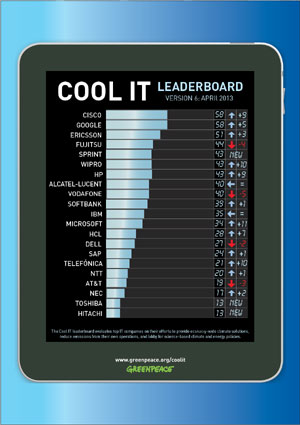Cisco and Google tied for first place in this year’s ranking of how the technology industry is addressing climate change.
Ericsson came in third, followed by Fujitsu, Sprint, and a tie between Wipro and HP for fifth place.
This is the sixth year Greenpeace evaluated the sector in its Cool IT Leaderboard report. They looked at 21 global IT and telecom firms on whether they offer IT solutions that cut energy demand across the economy; management of their own energy
footprints; and whether they use their influence to advocate for government policies that encourage the adoption of renewable energy and energy efficiency.
This year, Greenpeace finds more companies are increasing their commitment to renewable energy, but they are still not using their weight to advocate for energy policies that would unlock
investment in smart grid and other clean energy IT solutions.
"The IT sector’s progress will continue to be blocked by large, dirty electric utilities until more companies embrace their political power and advocate for climate-friendly decentralized energy policies," says Gary Cook, Senior IT Analyst for Greenpeace International.
For example, AT&T, Cisco, Google, IBM and Wipro all have operations in North Carolina, where Renewable Portfolio Standards (RPS) are under attack. If they joined to defend the RPS it would have a big impact and they could also join Google in demanding renewable energy be available from Duke Energy.
We
saw their potential for impact last year, when Google and other top websites blacked them out in opposition to an online privacy bill in Congress. It stopped it in its tracks.
On a national level there are promising signs on advocacy. Wipro, Google, Sprint and SoftBank have prioritized changing the laws governing our energy system, working to break down utility monopolies and incentivizing investment in energy efficiency and renewable energy.

Microsoft improved the most of all companies assessed, says Greenpeace, because it "finally used its considerable influence to support the extension of wind energy tax incentives," but importantly, it’s still a member of ALEC, one of the biggest obstacles to a transition to clean energy.
Oracle and Tata Communication Services were dropped this year because of a significant decline in performance, and because of Sharp’s restructuring, analysis has been tabled.
Apple, Facebook, and Amazon aren’t analyzed in the Leaderboard because their operations aren’t broad enough to be compared to companies that offer energy solutions to climate change as core aspects of their business models, says Greenpeace.
Some details on the highest ranked companies:
Google’s clean energy investments now exceed $1 billion since 2010, illustrating that corporations can play an important role in providing a new and much needed source of capital to the renewable energy sector. It also ranks high for policy advocacy, challenging the IT sector to work with them to bring more renewable energy to the grid and on attempting to influence US policy.
Its investments include some of the biggest, most important projects in the US: the Atlantic Wind Connection, a critical backbone for offshore wind transmission; Shepherds Flat, one of the world’s largest wind farms in Oregon; Ivanpah, an enormous solar project in California; and a portfolio of solar plants in Sacramento. It has 2 megawatts of solar PV on its rooftops and buys renewable energy to power its data centers, especially wind.
Although Cisco scores low for advocacy, it has transparent, well developed methods to measure the energy savings impact of its products, and has offered these as the basis of standardized measurements that could be used by the industry as a whole.
It appears to be increasing investments in energy solutions such as smart grid services and has committed to moving away from coal. Having met its first set of targets, Cisco updated them to cutting greenhouse gas emission 40% below 2007 levels and using renewables for 25% of energy by 2017.
It also works with suppliers to measure and report on their energy footprint and to establish reduction targets.
Read about last year’s IT Leaders.
Here’s the IT Leaderboard:

